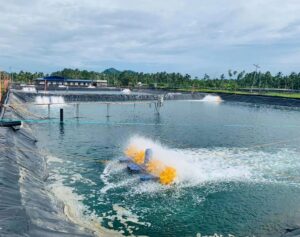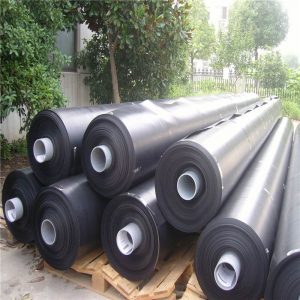What kind of fish is suitable for geomembrane?
Geomembranes can be applied to various types of fish farming, especially where there is a need to manage water bodies, prevent water leakage and reduce environmental impact.
Aquaculture: including freshwater aquaculture and marine aquaculture, such as carp, trout, grass carp, bass, eel, shrimp, shellfish, etc. The use of geomembranes can prevent water leakage in breeding ponds while reducing the risk of contamination of surrounding soil and water bodies.
Fish pond culture: Suitable for anti-penetration layer in fish pond culture. Fishpond culture can be a fish farming environment within a reservoir, pond or enclosure. Geomembranes can help prevent water from leaking into the soil, ensuring the stability and quality management of aquaculture water.
Aquatic plant planting: such as aquatic flowers, aquatic vegetables, lotus, etc. Geomembranes can be used as containers and planting beds for aquatic plants to maintain the supply of moisture and nutrients and prevent water leakage.
Fishing pond or fishing playground: Geomembrane can be used to build fishing ponds or fishing playgrounds to ensure the stability of the water body and pollution prevention and control, while providing a good fishing environment.
Aquatic scientific research experiments: In aquatic scientific research experiments, water quality, breeding environment and biological characteristics need to be strictly controlled. Geomembranes can be used to construct breeding sites with various controlled conditions to facilitate scientific experiments and data collection.

Is it necessary to use geotextile for fish farming with geomembrane?
In fish farming, both geomembranes and geotextiles can be used for specific application needs, but their use does not have to be used together. The following are the explanations and usage scenarios of geomembrane and geotextile:
Geomembrane: Geomembrane is a thin film material with good impermeability, which is often used in waterproof, anti-infiltration and soil protection applications. For fish farming purposes, geomembranes can be used as a waterproof layer to construct fish ponds, preventing water from penetrating into the soil and maintaining the stability of the water body.
Geotextile: Geotextile is a material with high strength, anti-corrosion and anti-penetration properties, which is usually used for soil reinforcement, anti-scouring and filtration.
In the case of fish farming, geotextiles can be used to reinforce the bottom or sides of the pond, prevent soil erosion and erosion, and provide soil support and stabilization effects.
Therefore, in the process of fish farming, according to actual needs and specific environmental conditions, you can choose to use geomembrane, geotextile or a combination of the two. If the soil is relatively stable and resistant to erosion, and the primary need is to prevent water penetration, then a geomembrane may be sufficient.
However, if you need to enhance the stability of the soil, the ability to resist erosion, and the protection of the bottom soil, you can choose to use geotextiles.
The best choice and combination depends on the specific fish farming scenario and needs. It is recommended that before choosing geomembranes and geotextiles, you should understand the local soil conditions, environmental characteristics, and special needs of fish farming in order to make appropriate decisions. In addition, when using geomembranes and geotextiles, they should be installed and maintained in accordance with relevant guidelines and requirements to ensure their good performance and effect.

Is fish farming with geomembrane environmentally friendly?
Using geomembranes for fish farming can provide environmental benefits to a certain extent, but there are also some environmental impacts and challenges. Here are some considerations for the environmental friendliness of geomembrane fish farming:
Water body protection: Geomembrane can prevent sewage from fish ponds from leaking into the soil and water bodies, reducing the negative impact on the surrounding environment. This helps protect the quality of groundwater and surface water bodies and prevent pollution and ecological damage.
Save water resources: Geomembranes can reduce water loss and waste and help the fish farming industry save water resources. Traditional soil fish farming methods usually require more water to replenish and replenish the amount of evaporated water.
Pollutant management: The use of geomembranes allows for better management of wastewater and cultured matter in fish ponds. Sewage can be collected, treated and treated to reduce the negative impact on the surrounding environment. In addition, the anti-seepage properties of geomembranes can also reduce the risk of farming waste seeping into soil and water bodies.
Soil protection: Geomembranes can prevent water from eroding the soil and reduce soil loss and deposition. This is of great significance for protecting soil quality and maintaining the health and sustainable development of farmland ecosystems.
Geomembrane fish farming may also face some environmental challenges
Material selection: The geomembrane material may contain certain chemical components. It is necessary to ensure that the selected geomembrane meets environmental protection requirements and will not have a negative impact on water quality and ecosystems.
Sewage treatment: The geomembrane fish farming system needs to consider the appropriate sewage treatment scheme, as well as the treatment and recovery of the cultured species and pollutants in the wastewater. If not handled properly, the discharged wastewater may still pollute water bodies and the environment.
Garbage disposal: During the geomembrane fish farming process, a certain amount of solid waste such as feed packaging bags and other garbage may be generated, which needs to be properly handled and managed.
In general, geomembrane fish farming can provide environmental benefits to a certain extent, but system design, wastewater treatment, and solid waste management need to be comprehensively considered to minimize the impact on the environment.
Author
-

Founded in 2002, Tinhy's team focuses on the manufacturing, marketing, installation, application and research and development of geosynthetic materials.
View all posts




